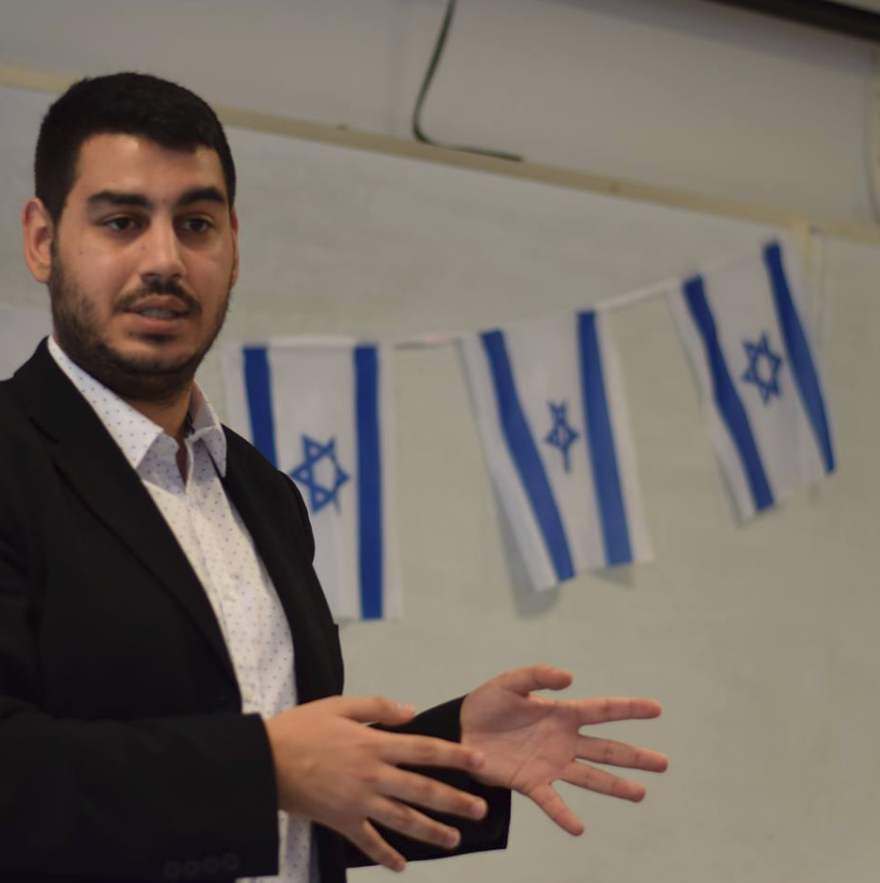Jonathan Elkhoury represents multiple minority groups in Israel. He told his life story to a rapt group of students at the University of Arizona Hillel Foundation on Dec. 1. His father fought for the South Lebanese Army against the Palestine Liberation Organization and fled to Israel when the Israel Defense Forces withdrew from South Lebanon in 2000. His family joined his father in 2001, when Elkhoury was 9, after a harrowing journey from Lebanon to Israel via Cyprus.
Settling in Haifa, the family was rejected by the local Arab community and its schools as traitors. Elkhoury, who spoke both Arabic and English, was accepted only by the Jewish schools, where teachers took turns teaching him Hebrew. Although he was embraced by the Jewish community, his first years in Israel coincided with the second intifada, making for a difficult and scary transition.
Receiving his Israeli ID card in 2006 was a turning point for Elkhoury. The high school student realized that “this is my home now.” The family received “a big hug” from the Israeli society, he says, as other Jewish families took them on tours around the country.

Elkhoury explained that as a Lebanese Christian, he is not Arab. Rather, his family can be traced back 15 generations in Lebanon, before the Muslims swept through the Middle East. His ethnic group traces its heritage to the early Christians who spoke Aramaic, not Arabic, which solidified his growing awareness of his identity. He points out that his roots are Phoenician, not Arab Muslim, and that his ethnic group is the original indigenous people of Syria, Lebanon and parts of Israel.
Receiving his IDF card, Elkhoury felt he could contribute in a meaningful way apart from entering the army. He chose national service, working in a hospital in Haifa. Although the IDF has had gay officers since 1999, he was also afraid to join the army as a young gay man.
With a Catholic mother and a Greek Orthodox father, Elkhoury struggled with his sexuality. Leaving home for three years to attend Western Galilee College in Acre afforded him the freedom to explore life, and gave his conservative family time to process his living as a gay man. Nevertheless, the Arab community as well as his Christian circle doesn’t talk about homosexuality, which is considered taboo. “It was like my whole family went into the closet with me,” he says. At this point, he feels fortunate there’s little written in Hebrew about his work in the gay community that his family could see.
Elkhoury is now a spokesman for the Christian Empowerment Council, founded by Father Gabriel Naddaf, a Greek Orthodox priest. The Council works for greater recognition by all Christians of the importance to participate in Israeli society. The Council’s mission is to encourage all Christians to contribute and be part of Israeli society, as well as to educate Christians worldwide about life in Israel. Naddaf was motivated by the growing ethnic cleansing and violence toward Christians in the Middle East, ushered in by the Arab Spring. Under Naddaf’s leadership the number of volunteers for the Israeli Army has increased from 35 to 150.
Tucson was Elkhoury’s final talk on a publicized tour of 19 college campuses in the United States, sponsored by CAMERA – Committee for Accuracy in Middle East Reporting in America. Back in Israel, he has been active in the Israeli Gay Youth, which organizes activities for gay Jewish and Muslim youth, in private environments. However, Elkhoury and the IGY are becoming more visible, as they build an LGBTQ space in Haifa to serve as an after-school youth center.
Today, Elkhoury also has his own food show on Israeli television to demonstrate the multi-cultural nature of Israeli society. He is proud that in 2014, the Israeli government recognized Aramaic Christians as a separate ethnic group from Arab Christians. His message is one of unity in diversity. “Israel is not an apartheid society,” he says. “I would like to go back to Lebanon to visit my family, but I live in Israel and that is where I need to make my contribution.”
Contributed by Ed Leven.
This article was originally published in the Arizona Jewish Post.

